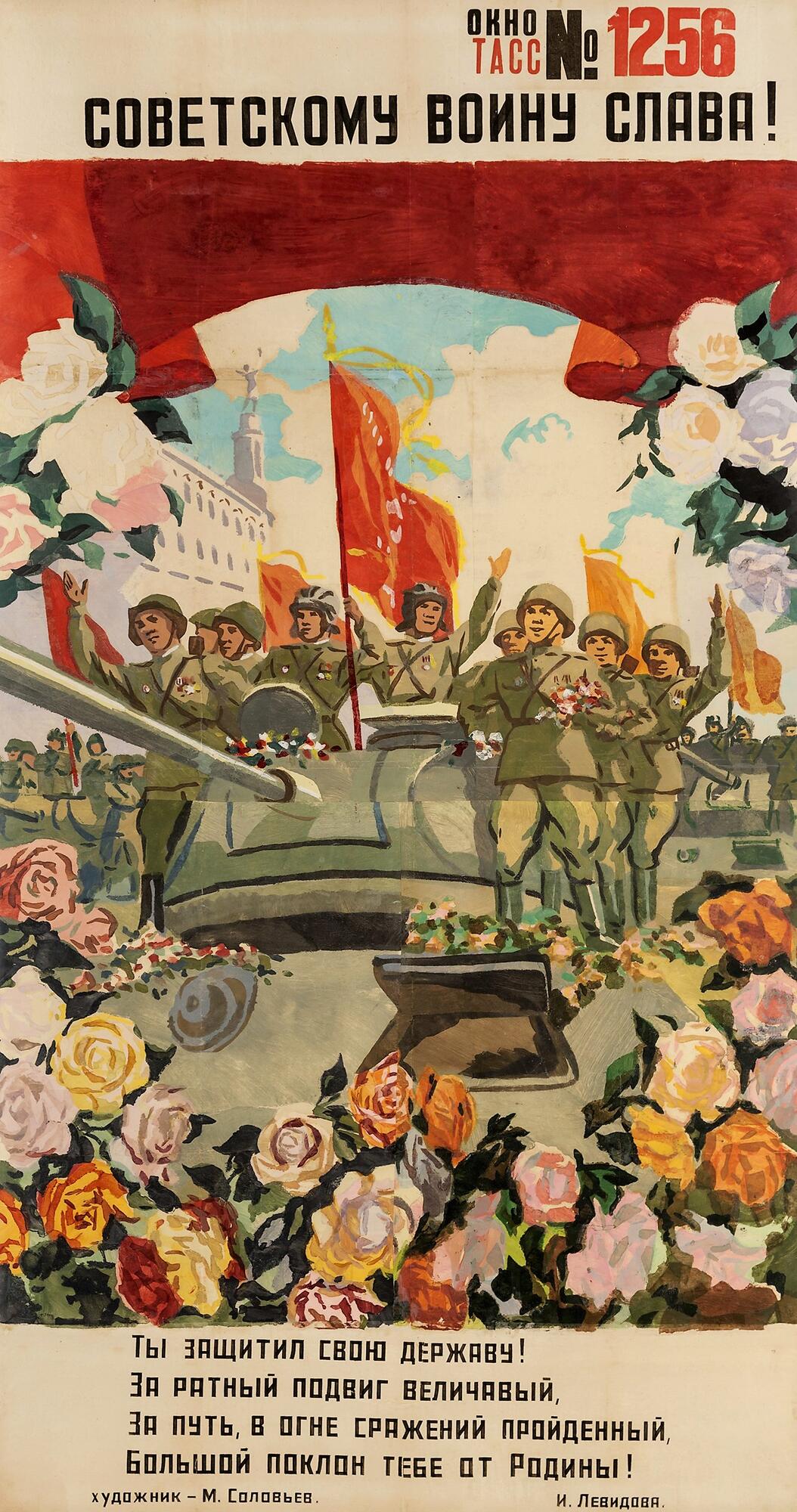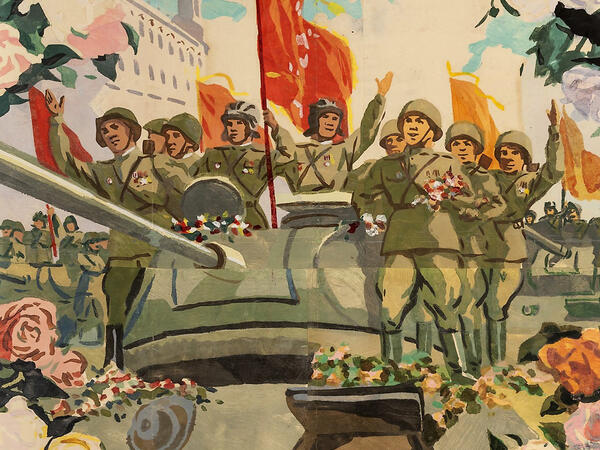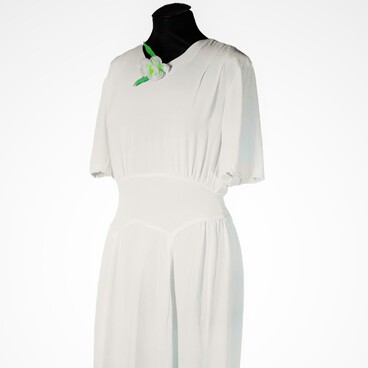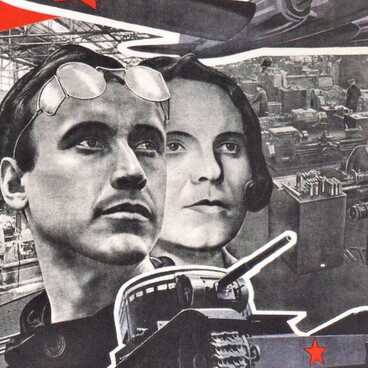The exhibition presents a copy of the poster ‘Glory to the Soviet soldier! ’ from 1945. Its original is kept in the museum’s funds.
In the USSR, posters became one of the most iconic types of fine art. During the war years, they were pasted on shop windows, walls, or fences. For a long time, posters remained the main means of mass agitation and raising popular forces, shaping people’s world view and attitudes.
During the Great Patriotic War of 1941-1945, ‘TASS Windows, ’ political agitational posters produced by the Soviet Union’s Telegraph Agency, appeared. “TASS Windows” were the successor of the earlier “ROSTA Windows”. The first posters appeared in Moscow, and then such posters were later produced in other cities: in Leningrad, Tashkent, Baku, Frunze, Ashkhabad, Tomsk, Saratov, Murmansk, Khabarovsk, and Sverdlovsk.
The “TASS Windows” staff was assembled on June 24, 1941, at the first organizational meeting in the Union of Artists. Already on July 27 of the same year, at 4 p.m. in Moscow, the first posters were hung out on the Kuznetsky Bridge — sheets of wrapping paper, with drawings and text on them. They were stenciled in three to five colors.
The “TASS Windows” became a formidable ideological weapon. They were well known both at the front and in the rear, in the occupied territory and partisan detachments, in many countries of the world and in Germany itself. Recognized artists, poets, and writers created them: Vasily Lebedev-Kumach, Alexander Zharov, Sergey Mikhalkov, Konstantin Simonov, Ilya Ehrenburg, Samuel Marshak. Moreover, many artists worked in the genre of poster art during the Great Patriotic War, despite the fact that they were not engaged in poster work either before or after it.
The subjects of “Windows” were diverse: among them, there were heroic and satirical posters, as well as proclamation posters. They helped to overcome the hardships of wartime and gave confidence in the fight against the enemy. According to some reports, the German military leaders disliked Soviet posters so much that they created a separate directive: after the capture of Moscow, German officers were ordered to “hang everyone who worked in 'TASS Windows' on lampposts”.
The poster of 1945 No. 1256 ‘Glory to the Soviet soldier! ’ illustrates the honoring of the victorious soldiers, popular rejoicing, and the joy of victory. The wrapping paper on which such posters were drawn was very fragile, over time cracks and tears appeared in it. In 2014-2015, the original was restored by Maria Kupriyanova and Olga Temerina, specialists of the All-Russian Art Research and Restoration Center named after Academician Grabar.
In the USSR, posters became one of the most iconic types of fine art. During the war years, they were pasted on shop windows, walls, or fences. For a long time, posters remained the main means of mass agitation and raising popular forces, shaping people’s world view and attitudes.
During the Great Patriotic War of 1941-1945, ‘TASS Windows, ’ political agitational posters produced by the Soviet Union’s Telegraph Agency, appeared. “TASS Windows” were the successor of the earlier “ROSTA Windows”. The first posters appeared in Moscow, and then such posters were later produced in other cities: in Leningrad, Tashkent, Baku, Frunze, Ashkhabad, Tomsk, Saratov, Murmansk, Khabarovsk, and Sverdlovsk.
The “TASS Windows” staff was assembled on June 24, 1941, at the first organizational meeting in the Union of Artists. Already on July 27 of the same year, at 4 p.m. in Moscow, the first posters were hung out on the Kuznetsky Bridge — sheets of wrapping paper, with drawings and text on them. They were stenciled in three to five colors.
The “TASS Windows” became a formidable ideological weapon. They were well known both at the front and in the rear, in the occupied territory and partisan detachments, in many countries of the world and in Germany itself. Recognized artists, poets, and writers created them: Vasily Lebedev-Kumach, Alexander Zharov, Sergey Mikhalkov, Konstantin Simonov, Ilya Ehrenburg, Samuel Marshak. Moreover, many artists worked in the genre of poster art during the Great Patriotic War, despite the fact that they were not engaged in poster work either before or after it.
The subjects of “Windows” were diverse: among them, there were heroic and satirical posters, as well as proclamation posters. They helped to overcome the hardships of wartime and gave confidence in the fight against the enemy. According to some reports, the German military leaders disliked Soviet posters so much that they created a separate directive: after the capture of Moscow, German officers were ordered to “hang everyone who worked in 'TASS Windows' on lampposts”.
The poster of 1945 No. 1256 ‘Glory to the Soviet soldier! ’ illustrates the honoring of the victorious soldiers, popular rejoicing, and the joy of victory. The wrapping paper on which such posters were drawn was very fragile, over time cracks and tears appeared in it. In 2014-2015, the original was restored by Maria Kupriyanova and Olga Temerina, specialists of the All-Russian Art Research and Restoration Center named after Academician Grabar.





